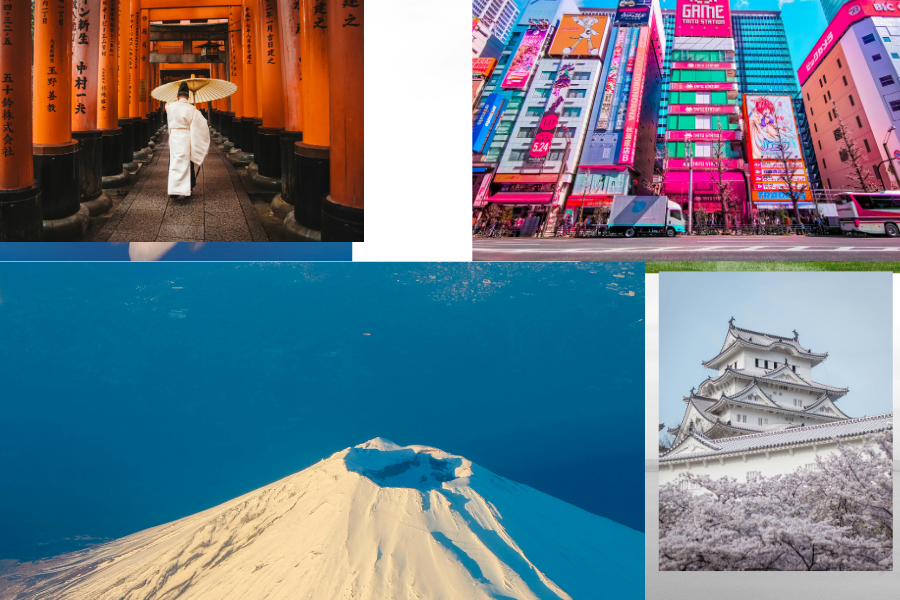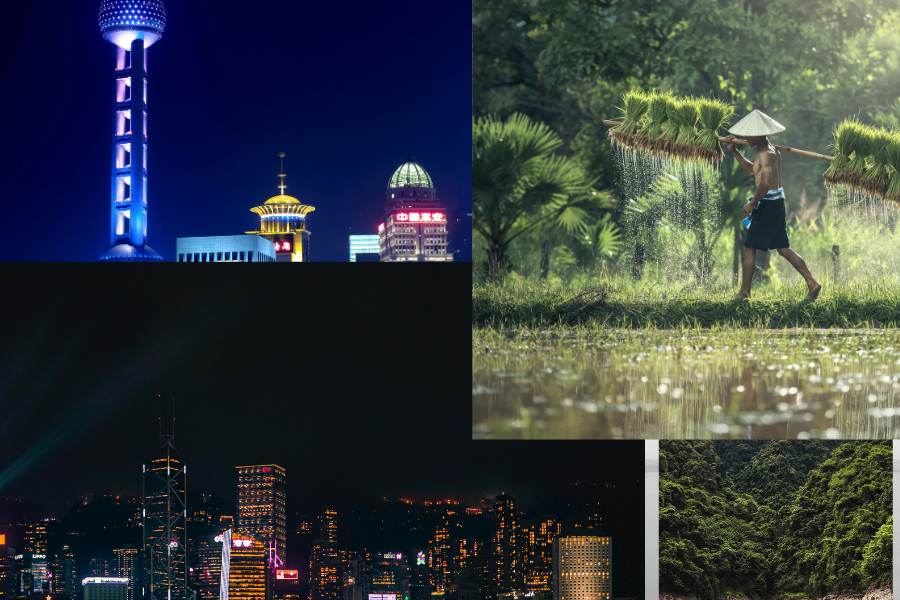About Japan:
A Geographical Journey through Japan
Island Tapestry:
Japan isn’t just one landmass, but a breathtaking archipelago of over 6,800 islands scattered like jewels across the Pacific Ocean. The four largest, Honshu, Hokkaido, Kyushu, and Shikoku, hold the bulk of the population and historical landmarks, yet each boasts distinct landscapes and personalities.
Honshu: The heartland, where bustling Tokyo and serene Kyoto reside, is carved by mountain ranges and fertile plains. From the iconic peak of Mount Fuji to the vibrant neon cityscape, Honshu offers a dynamic blend of nature and urban energy.
Hokkaido: The northernmost island, nicknamed “the Land of the North,” is a wonderland of vast wilderness. Volcanic mountains pierce the sky, vast national parks teem with wildlife, and pristine coastlines offer breathtaking views.
Kyushu: The southernmost bastion, known for its volcanic activity and hot springs, exudes a subtropical charm. Explore active volcanoes like Mount Aso, relax in steaming onsen, or delve into the rich cultural heritage of Fukuoka and Nagasaki.
Shikoku: The smallest of the four major islands, Shikoku is often called “Japan’s best-kept secret.” Journey through its serene valleys, discover ancient temples nestled amidst lush forests, and experience the laid-back charm of traditional Japanese life.
Volcanic Majesty:
Japan’s geography is deeply intertwined with its volcanic activity. Nestled on the “Ring of Fire,” a chain of volcanoes encircling the Pacific Ocean, Japan experiences frequent tremors and eruptions. This fiery past has sculpted dramatic landscapes, from the iconic cone of Mount Fuji to the geothermal wonders of Hokkaido.
Earthquakes and Resilience:
The flip side of this volcanic activity is the constant threat of earthquakes. While tremors are a reality of life in Japan, the country is a leader in earthquake preparedness and mitigation. Advanced warning systems, innovative building techniques, and regular drills ensure the safety of residents and minimize the impact of these natural events.
Beyond the Surface:
Beneath the land, Japan boasts a wealth of natural resources. From the mineral-rich mountains to the fertile plains and productive fisheries, the land provides sustenance and economic possibilities. The diverse ecosystems also harbor unique flora and fauna, adding to the richness of Japan’s natural tapestry.
Exploring Further:
This is just a glimpse into the captivating geography of Japan. Each island holds its own unique stories, waiting to be discovered. So, pack your bags, embrace the spirit of adventure, and embark on your own geographical journey through the Land of the Rising Sun!
Japanese Culture: A Journey Beyond the Surface
Japan’s culture, a vibrant tapestry woven with threads from across Asia, offers a unique and captivating experience for any visitor. Let’s delve deeper into some of its most well-known aspects:
Tea Ceremonies: A Ritual of Tranquility:
Step into the serene world of the tea ceremony, where every movement is imbued with meaning and mindfulness. Witness the meticulous preparation of matcha tea, the precise whisking, and the sharing of delicate sweets in a tranquil space. This ancient ritual fosters inner peace, appreciation for simplicity, and connection with others.
Calligraphy: Dancing Brushstrokes of Beauty:
Admire the art of calligraphy, where brushstrokes dance across paper, breathing life into Japanese characters. Each stroke embodies years of practice, discipline, and artistic expression. Witness the creation of intricate characters, each carrying the weight of history and cultural significance.
Kabuki Theater: A Theatrical Extravaganza:
Immerse yourself in the vibrant world of Kabuki theater, where larger-than-life characters adorned with elaborate costumes and makeup captivate audiences. Witness the dramatic performances, the stylized movements, and the powerful storytelling that has enthralled theatergoers for centuries.
Kimono: A Timeless Fashion Statement:
Drape yourself in the elegance of a kimono, a traditional garment that embodies centuries of cultural refinement. Appreciate the intricate patterns, the delicate fabrics, and the way it flows with grace and poise. Wearing a kimono isn’t just about fashion; it’s a cultural experience that connects you to Japan’s rich history and aesthetic sensibilities.
Anime and Manga: Pop Culture Powerhouses:
Dive into the fantastical worlds of anime and manga, where imagination takes flight through animation and comics. Explore stories that span genres, from action-packed adventures to heartwarming tales, each with its own unique artistic style and cultural touchstones. These pop culture powerhouses not only entertain but also offer a window into contemporary Japanese society and values.
Visa and Passport:
- Visa Maze: A Guide for Indian Travelers to Japan
- Planning a trip to Japan from India is exciting, but obtaining the necessary visa can seem daunting. Fear not! Here’s a comprehensive guide to help you navigate the process smoothly:
- Do You Need a Visa?
- Yes, Indian citizens require a visa to enter Japan for tourism purposes. This applies to both single-entry and multiple-entry visas.
- Types of Visas:
- Single-entry visa: This allows you to enter Japan once within the validity period of the visa (usually 3 months or 1 year).
- Multiple-entry visa: This allows you to enter and leave Japan multiple times within the validity period (usually 3 years or 5 years).
- Application Process:
- Gather Required Documents:
- Valid passport with at least 6 months validity beyond your intended stay in Japan.
- Completed visa application form (downloadable from the Embassy website).
- Two recent passport-sized photographs.
- Proof of confirmed travel arrangements (flight tickets, hotel bookings).
- Proof of sufficient funds to support your stay (bank statements, salary slips).
- Letter of explanation outlining your purpose of visit and itinerary.
- Additional documents may be required depending on your specific circumstances.
- Choose the Application Method:
- Apply directly at the Embassy of Japan in India or the Consulate General of Japan in Mumbai, Chennai, or Kolkata.
- Apply through a designated visa application center (VAC).
- Submit Application and Fees:
- Pay the visa fee (approximately INR 5,400 for a single-entry visa).
- Submit your application and documents within the specified deadlines.
- Processing Time:
- Allow 5-7 working days for the visa application to be processed.
- Visa Collection:
- Collect your passport with the visa decision upon notification.
- Additional Tips:
- Start the visa application process well in advance of your planned travel date.
- Ensure all documents are complete and accurate before submission.
- Double-check the visa fee amount and payment methods before applying.
- For the latest information and updates, visit the official website of the Embassy of Japan in India: https://www.in.emb-japan.go.jp/itpr_en/Visa.html
Your Passport to Japan: Ensuring a Smooth Journey
Before embarking on your exciting adventure to Japan, it’s crucial to ensure your passport is in order. Here’s a comprehensive guide to help you avoid any last-minute hiccups:
Validity:
- Minimum Validity: Your passport must be valid for at least 6 months beyond your intended date of departure from Japan. This is a standard requirement for most countries, including Japan.
- Additional Buffer: Consider having a longer validity period, especially if you plan to travel further after Japan or anticipate any delays in your return.
- Check Early: Don’t wait until the last minute to check your passport validity. Renewing a passport can take time, so plan ahead and avoid unnecessary stress.
Blank Pages:
- Visa Stamp Requirement: Make sure your passport has at least two blank pages specifically designated for visa stamps. Some countries, including Japan, require a separate page for each visa stamp.
- Additional Pages: If you travel frequently or anticipate needing multiple visas in the future, consider getting a passport with more pages.
- Checking Your Pages: Count the blank pages available in your passport, excluding those with handwritten notes or endorsements.
Transportation india to Japan:
Flights from India to Japan
Taking flight is the quickest and most comfortable way to bridge the distance between India and Japan. Let’s delve into the details to ensure a smooth and budget-friendly journey:
Direct Flights:
Several airlines offer direct connections from major Indian cities like Delhi, Mumbai, Chennai, and Bangalore to popular Japanese destinations like Tokyo, Osaka, Nagoya, and Fukuoka. This eliminates the hassle of connecting flights and saves precious travel time.
Popular Airlines:
- From India: Air India, Japan Airlines (JAL), All Nippon Airways (ANA), IndiGo, SpiceJet, Vistara.
- From Japan: JAL, ANA, Peach Aviation, Jetstar Japan.
Finding Deals:
Flight comparison websites like Skyscanner, Kayak, Momondo, and Google Flights can be your best allies in finding the most affordable options. Utilize filters based on price, travel dates, airlines, and preferred airports.
Booking Tips:
- Consider off-season travel: Prices tend to be lower during shoulder seasons (spring/autumn) compared to peak tourist periods (summer/winter).
- Be flexible with dates and airports: Traveling on weekdays or choosing alternative airports can sometimes lead to significant cost savings.
- Sign up for airline and travel website alerts: Stay updated on flash sales, promotional offers, and price drops for your desired route.
- Book in advance: Planning ahead, especially during peak seasons, often leads to better deals compared to last-minute bookings.
Additional Considerations:
- Flight duration: Direct flights from India to Japan typically range from 7 to 9 hours, depending on the route and airline.
- Baggage allowance: Check the baggage allowance included in your ticket and consider purchasing additional baggage if needed.
- In-flight services: Airlines offer various in-flight services like meals, entertainment, and Wi-Fi. Research these beforehand to make an informed decision.
Rails Across Continents: The Trans-Siberian Journey to Japan
While direct train routes from India to Japan remain a dream for now, train enthusiasts can embark on an epic adventure via the Trans-Siberian Railway. This legendary journey transcends borders, offering a unique perspective on landscapes and cultures before reaching the shores of Japan.
The Trans-Siberian Experience:
- Route: Starting in Delhi, the Trans-Siberian Railway traverses vast stretches of Russia, passing through Siberia, the Ural Mountains, and Mongolia before reaching Vladivostok on the Pacific coast.
- Duration: This epic journey takes approximately 14-16 days, depending on chosen stops and train speed. Prepare for a slow and immersive travel experience.
- Comfort: Different classes of service are available, ranging from budget-friendly shared compartments to private cabins with en-suite bathrooms.
- Highlights: Witness diverse landscapes, from snow-capped mountains and vast plains to bustling cities and remote villages. Immerse yourself in the unique cultures of Russia and Mongolia along the way.
Reaching Japan:
- Ferry: From Vladivostok, board a ferry across the Sea of Japan to reach Japanese ports like Hokkaido or Honshu. The journey takes approximately 18-48 hours, depending on the route and ferry operator.
- Cost: The combined cost of train tickets and ferry crossings can be significantly higher compared to flying directly from India to Japan.
Considerations:
- Visa Requirements: Ensure you have valid visas for all countries you’ll be transiting through, including Russia, Mongolia, and Japan.
- Language Barriers: Basic knowledge of Russian and Japanese can be helpful, but translation apps and phrasebooks can also be handy.
- Weather: Be prepared for varying weather conditions, from scorching summers in Mongolia to freezing winters in Siberia. Pack accordingly.
- Adventure vs. Convenience: Choose this option if you prioritize a unique travel experience over speed and budget constraints.
No Cross-Continental Buses: Exploring Japan’s Local Bus Network
While bridging the vast distance between India and Japan by bus might be a fantastical dream, navigating within Japan’s diverse landscapes using buses is a practical and budget-friendly option. Here’s a breakdown of what you need to know:
Inter-country Bus Void:
Unfortunately, there are currently no direct bus services connecting India and Japan. The sheer distance and lack of land bridges make such a journey impractical. However, fear not, as other modes of transportation like flights and trains offer efficient options for your cross-continental journey.
Embracing Local Buses Within Japan:
Once you reach Japan, a network of local buses awaits to connect you to various destinations. These buses offer a cost-effective way to explore cities, towns, and even rural areas. Here’s what you can expect:
- Extensive Network: Buses operate in most major cities and towns, covering different routes and neighborhoods. You can find express buses for longer distances and local buses for shorter trips within city limits.
- Ticket Options: Single-ride tickets and day passes are available, with prices varying based on distance and type of bus. Consider purchasing pre-paid travel cards for frequent bus users, offering convenience and potential discounts.
- Language Barrier: While English signage and announcements might be limited, basic Japanese phrases or translation apps can help navigate routes and buy tickets. Don’t hesitate to ask locals for assistance if needed.
- Luggage Considerations: Smaller buses might have limited space for luggage, so pack light if using buses for long journeys. Consider alternative luggage storage options if necessary.
- Unique Experiences: Buses offer a window into everyday Japanese life, allowing you to interact with locals and observe their travel habits. Enjoy the scenic views and the slower pace compared to bullet trains.
Finding Your Nest in the Land of the Rising Sun: Exploring Japan’s Accommodation Options
Japan boasts a vibrant hospitality scene, catering to every budget and travel style. From the sleek minimalism of capsule hotels to the immersive charm of traditional ryokans, choosing your accommodation can be an exciting part of planning your Japanese adventure. Here’s a closer look at some popular options for Indian travelers:
Capsule Hotels:
- Budget-friendly: A unique and affordable experience, offering individual sleeping pods equipped with basic amenities. Ideal for solo travelers seeking a clean and efficient stay.
- Location: Often found in central areas, providing convenient access to public transportation and attractions.
- Considerations: Shared bathrooms and limited space might not suit everyone. Research different capsule hotels for varying facilities and atmospheres.
Business Hotels:
- Comfort and Convenience: Clean, functional rooms with essential amenities like Wi-Fi, en-suite bathrooms, and sometimes laundry facilities.
- Value for Money: Often located near train stations, offering good value for the price. Popular choice for both leisure and business travelers.
- Considerations: Rooms can be small, and amenities might be limited compared to higher-end hotels.
Guesthouses:
- Local Charm: Experience Japanese hospitality in a homestay-style setting. Interact with local hosts and gain insights into Japanese culture.
- Unique Flavors: Enjoy homemade meals and personalized recommendations for exploring hidden gems.
- Considerations: Amenities might vary depending on the guesthouse. Research reviews and choose one that resonates with your preferences.
Additional Options:
- Ryokans: Immerse yourself in Japanese tradition by staying in a ryokan, offering tatami-mat rooms, communal baths (onsen), and traditional meals. Be prepared for higher prices compared to other options.
- Hostels: Ideal for budget-conscious travelers seeking a social atmosphere and opportunities to meet fellow travelers.
- Apartments: Consider renting an apartment for longer stays, offering more space and kitchen facilities for self-catering.
Tips for Indian Travelers:
- Booking Platforms: Websites like Booking.com, Agoda, and Airbnb offer wide selections of accommodations in Japan, often with English language support. Consider searching specifically for “India-friendly” hotels for amenities like vegetarian options.
- Location: Choose a location based on your travel plans and preferred access to public transportation, attractions, and desired experiences.
- Seasonality: Prices can fluctuate depending on the season. Book in advance during peak seasons (spring and autumn) to secure availability and potentially better deals.
Japan Through Airbnb: Finding Your Home Away From Home
While hotels offer a convenient and familiar experience, immersing yourself in local life and culture can be truly enriching. This is where Airbnb shines, allowing you to rent apartments and private homes directly from local hosts, offering a unique perspective on Japanese living.
Affordability for Longer Stays:
Compared to hotels, Airbnb apartments can be significantly more affordable, especially for longer stays. You’ll often have access to a kitchen, which allows you to cook your own meals and save on dining costs. This is particularly beneficial for travelers with dietary restrictions or those seeking authentic culinary experiences.
Beyond Affordability:
The benefits go beyond just cost. Airbnb rentals often offer more space and a more “homey” feel than hotel rooms. You might have access to amenities like laundry facilities, balconies, or even small gardens, enhancing your comfort and sense of connection to the local environment.
Unique Experiences:
By staying in a local neighborhood, you’ll be closer to everyday life and culture. Interact with your host, who can offer personalized recommendations for exploring hidden gems and experiencing local traditions. This can create a more authentic and memorable travel experience.
Considerations & Tips:
- Read Reviews Carefully: Before booking, thoroughly read guest reviews to gauge the host’s responsiveness, the apartment’s condition, and the overall experience of previous guests.
- Communication is Key: Clear communication with your host is crucial. Ask questions about the apartment, amenities, neighborhood, and any house rules.
- Be Culturally Aware: Respect local customs and traditions when staying in a residential area. Be mindful of noise levels and adhere to any community guidelines.
- Understand Airbnb Regulations: Research local regulations regarding Airbnb rentals in the specific city or town you’re visiting, as some areas have restrictions.
Navigating the Yen: Currency Tips for Your Japanese Adventure
Planning your trip to Japan? Understanding the local currency and managing your finances is crucial for a smooth and enjoyable experience. Here’s a comprehensive guide to navigating the Japanese Yen (JPY) and making smart money decisions:
The Yen Reigns Supreme:
Japan’s official currency is the Japanese Yen (JPY), denoted by the symbol ¥. Familiarize yourself with the different denominations of Yen bills (¥1,000, ¥2,000, ¥5,000, ¥10,000) and coins (¥1, ¥5, ¥10, ¥50, ¥100, ¥500).
Exchange Strategies:
- Before Your Trip: Exchange a small amount of INR to JPY before your departure for immediate needs like transportation or small purchases. This provides peace of mind upon arrival.
- ATMs in Japan: The most convenient way to get JPY is by withdrawing from ATMs in Japan. Look for ATMs with English interfaces and ensure your bank card has international withdrawal capabilities. Be aware of potential withdrawal fees charged by your bank and the ATM operator.
- Currency Exchange Offices: These offer competitive rates, but compare fees and exchange rates before choosing one. Airports and major tourist areas often have exchange offices, but rates might be less favorable.
Remember:
- Compare Rates: Always compare exchange rates before converting your money. Online tools and travel apps can help you find the best deals.
- Declare Large Amounts: Declare any amount exceeding ¥1 million JPY upon arrival or departure from Japan.
- Cash vs. Card: While cash is still widely accepted, credit and debit cards are increasingly used in major cities. However, always carry some cash for smaller shops and taxis that might not accept cards.
Additional Tips:
- Consider acquiring a travel card like Revolut or Wise for competitive exchange rates and fee-free ATM withdrawals abroad.
- Research local tipping etiquette in Japan, as tipping is not customary in most cases.
- Download budgeting apps to track your expenses and stay within your budget.
A Culinary Journey Through Japan: From Delicate Flavors to Budget Bites
Japanese cuisine is a vibrant symphony of fresh, seasonal ingredients, artistic presentation, and unique flavors. Get ready to tantalize your taste buds with an array of culinary delights, from the iconic sushi to hidden gems like street food and convenience store treats.
A World of Flavors:
- Savour the Classics: Dive into the world-famous sushi, with its melt-in-your-mouth seafood and perfectly seasoned rice. Slurp down steaming bowls of ramen, noodle soups bursting with umami-rich broth and flavorful toppings. Delight in the crispy perfection of tempura, lightly battered and fried vegetables and seafood.
- Beyond the Mainstream: Explore the diverse regional specialties, like the hearty okonomiyaki savory pancakes of Osaka or the delicate kaiseki multi-course meals of Kyoto. Don’t miss yakitori, grilled skewers of chicken and vegetables, perfect for a casual snack.
- Vegetarian and Vegan Options: Contrary to popular belief, Japan offers a surprising variety of plant-based dishes. Enjoy tofu in various preparations, savor vegetable tempura, and explore Buddhist temple cuisine for unique vegetarian experiences.
Budget-Friendly Bites:
- Convenience Stores: Don’t underestimate the culinary treasures found in konbini, Japanese convenience stores. From onigiri rice balls and bento boxes to delicious sandwiches and ready-made meals, they offer a convenient and affordable way to satisfy your hunger.
- Street Food Delights: Dive into the vibrant world of yatai, street food stalls offering an array of delicious and budget-friendly options. Try takoyaki octopus balls, yakitori skewers, or okonomiyaki on the go.
- Local Markets: Immerse yourself in the bustling atmosphere of local markets and discover fresh seasonal produce, local specialties, and street food stalls at affordable prices.
A Touch of Home:
Feeling a pang of nostalgia? Major cities like Tokyo and Osaka offer a variety of Indian restaurants catering to your familiar flavors. Enjoy a comforting curry or indulge in delicious samosas to satisfy your cravings.
Top Places to Visit:
Tokyo:
- Iconic Landmarks:
- Imperial Palace: Explore the serene gardens and historical significance of the Emperor’s residence. The East Garden offers panoramic views and a glimpse into Japanese imperial history.
- Senso-ji Temple: Immerse yourself in the vibrant atmosphere of this ancient temple, bustling with vendors and offering a unique cultural experience.
- Tokyo Tower: Ascend to the top for breathtaking 360-degree views of the city skyline, capturing both modern marvels and historical landmarks.
- Modern Districts:
- Shibuya: Dive into the heart of fashion trends and electrifying nightlife, where the iconic Shibuya Crossing presents a mesmerizing spectacle of pedestrian flow.
- Shinjuku: Feel the pulse of the city in this dynamic district, packed with towering skyscrapers, diverse restaurants, and lively bars offering entertainment for all tastes.
- Harajuku: Embrace the unique and expressive fashion culture, where creativity and individuality shine through in vibrant outfits, quirky shops, and trendy cafes.
Kyoto:
- Ancient History and Traditional Culture:
- Kiyomizu-dera Temple: Witness the architectural wonder of this hillside temple, known for its iconic stage offering breathtaking views and a serene atmosphere.
- Arashiyama Bamboo Grove: Wander through a peaceful path lined with towering bamboo stalks, creating a tranquil escape amidst the city’s bustle.
- Kinkaku-ji Temple (Golden Pavilion): Be captivated by the dazzling temple adorned with gold leaf, reflecting beautifully in the surrounding pond and embodying the city’s rich cultural heritage.
Osaka:
- Culinary Delights and Dynamic Energy:
- Foodie Paradise: Embark on a culinary adventure through the renowned “kitchen of Japan,” savoring street food like okonomiyaki and takoyaki, or indulging in the rich flavors of Osaka ramen.
- Nightlife Buzz: Immerse yourself in the vibrant nightlife scene, where bars, restaurants, and karaoke spots offer diverse entertainment options for all preferences.
- Theme Park Fun: Unleash your inner child and experience thrilling rides, exciting shows, and beloved characters at Universal Studios Japan.
Hiroshima:
- Reflecting on History:
- Hiroshima Peace Memorial Park: Pay respects at this park dedicated to the victims of the atomic bomb, and gain insights into the city’s history through monuments and memorials.
- Hiroshima Peace Memorial Museum: Delve deeper into the story of the atomic bombing and its aftermath through exhibits, artifacts, and personal accounts, promoting peace and understanding.
- Exploring Miyajima Island:
- Itsukushima Shrine: Witness the iconic shrine built on the water, offering a unique and unforgettable experience. Admire its architecture and significance within Japanese culture.
Mount Fuji:
- Challenge and Scenic Beauty:
- Hiking and Climbing: Choose from various trails and embark on a challenging yet rewarding ascent of the iconic Mount Fuji, the highest mountain in Japan, and witness breathtaking views from the summit.
- UNESCO World Heritage Site: Appreciate the natural beauty and cultural significance of this majestic mountain, recognized for its unique landscape and historical importance.
Planning Tips:
- Ideal Seasons: Consider visiting during the spring (March-May) or autumn (September-November) for pleasant weather and comfortable explorations.
- Japan Rail Pass: Utilize this pass for cost-effective travel across multiple destinations, especially if planning extensive journeys within Japan.
- Basic Japanese Phrases: Learning some key phrases can enhance your communication and interaction with locals, making your trip more enjoyable.
- Safety and Precautions: Tokyo is generally safe, but be mindful of your surroundings and take basic precautions like any other travel destination.
- Culinary Adventures: Don’t miss the opportunity to savor the diverse and delicious flavors of Japanese cuisine, from street food to fine dining experiences.
Pack Your Bags and Immerse Yourself in Japan: Travel Tips Straight from the Source!
Navigating the Rails:
- Japan Rail Pass: If your itinerary involves crisscrossing the country, the Japan Rail Pass can be a budget-friendly option. Research routes and costs beforehand to see if it fits your needs.
- Local Transit: For shorter hops, embrace the convenience of subways and buses. Download apps like Jorudan or Google Maps for real-time schedules and information.
Language Magic:
- Unlocking Communication: Learn some basic Japanese phrases like “hello” (konnichiwa), “thank you” (arigatou gozaimasu), and “excuse me” (sumimasen). Even basic greetings show respect and ease communication.
- Tech-Savvy Solutions: Invest in offline translation apps or dictionaries for on-the-go assistance, especially in areas with limited English.
Etiquette Essentials:
- Cultural Nuances: Be mindful of bowing customs, removing shoes in certain settings, and respecting personal space. A little research goes a long way!
- Public Transport Harmony: Keep conversations and calls to a minimum on trains and buses. Observe the peaceful atmosphere.
- Respect the Queue: Patience and respect are key! Avoid cutting in line and wait your turn politely.
Packing Prowess:
- Adapt to the Seasons: Japan’s climate varies across regions and times of year. Pack versatile clothing and layers for flexibility.
- Footwear for Exploration: Walking is common, so prioritize comfortable shoes suitable for different terrains, whether exploring bustling cities or serene nature trails.
- Must-Have Essentials: Don’t forget essentials like sunscreen, rain gear, and adapters depending on your travel dates and destinations.
Tech Tools for the Journey:
- Offline Maps as Your Guide: Download offline maps or purchase a physical map for reliable navigation, especially in rural areas with limited internet access.
- Stay Connected: Consider purchasing a local data SIM card for internet access on the go, but be mindful of roaming charges.
- Translation Apps: Your Linguistic Savior: Invest in offline translation apps like Google Translate or Papago for language assistance throughout your trip.
Bonus Tips:
- Currency Exchange: Research and plan your currency exchange needs. Consider using ATMs or pre-purchasing some Yen for convenience.
- Accommodation: Book accommodations in advance, especially during peak seasons. Consider traditional ryokan experiences for a unique cultural immersion.
- Travel Insurance: Secure comprehensive travel insurance for peace of mind and unforeseen circumstances.
- Embrace Local Adventures: Research and participate in local activities, festivals, or cultural events to deepen your understanding and create lasting memories.











